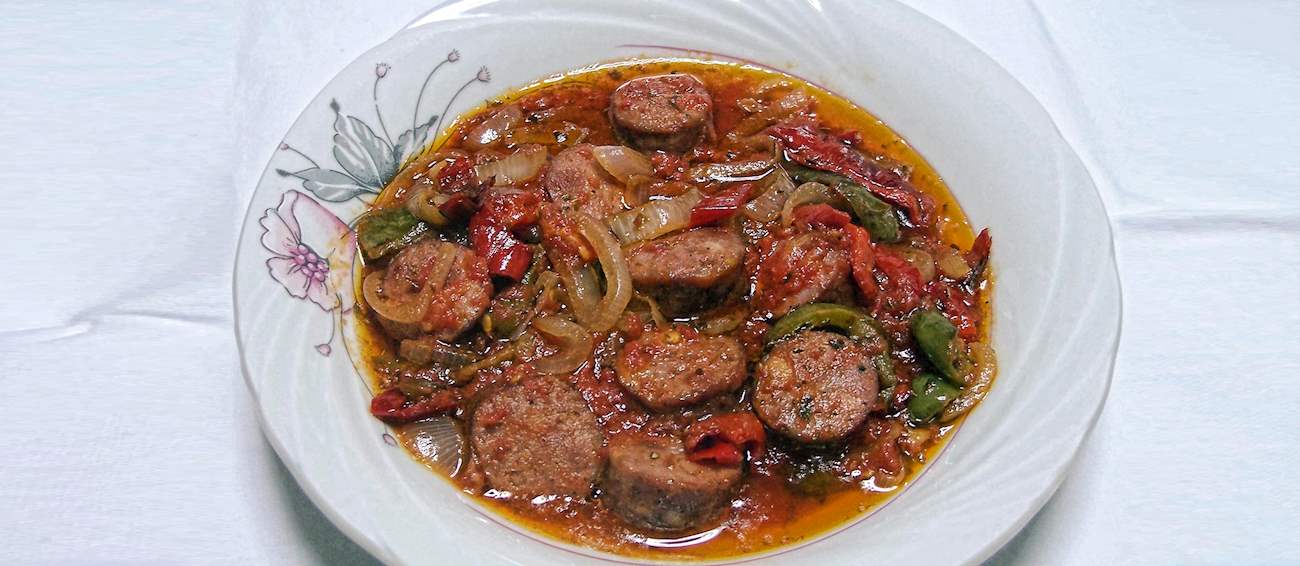MAIN INGREDIENTS
Calentado is a traditional breakfast consisting of last night's leftovers that are simply reheated. It stems from the past, when much of the Colombian population lived in poverty and nothing was wasted. This hearty breakfast usually includes rice, beans, plantains, steak, fried eggs, and arepas.
Some people like to add other ingredients as well, such as sausages or chicharrónes. Nowadays, calentado is typically served on weekends due to the sheer amount of food, and it is recommended to serve it with coffee or a cup of hot chocolate on the side.
MAIN INGREDIENTS
Hailing from the Thessaly region, this rustic dish combines sausages, locally referred to as loukaniko, and bell peppers, all sliced into larger chunks and doused in a rich tomato sauce. Spetsofai is commonly elevated with hot peppers which provide the welcoming heat during the colder winter months.
The dish is a tavern staple across Central Greece, and it can be enjoyed as a meze dish or a main course that perfectly pairs with rice, potatoes, or feta cheese and country-style bread on the side.
MAIN INGREDIENTS
Cocido lebaniego is a traditional dish originating from the Liébana area in Cantabria. The stew consists of local chickpeas, potatoes, and cabbage with meat from the pig slaughter such as chorizo, bacon, and morcilla. Breadcrumbs, parsley, and cecina dried meat is often added to the stew as well.
Due to the fact that the stew is very hearty and nutritious, it's traditionally eaten as the main course. The consommé is enjoyed first, followed by the chickpeas and vegetables, while the meat is usually saved for last, although some like to eat the meat and the chickpeas together.
MAIN INGREDIENTS
Żurek is a traditional soup characterized by its distinctively sour taste, which comes from sour leavening, or the fermentation of bread and rye flour. The soup also contains meats such as sausages, bacon, or ham, and vegetables such as potatoes and mushrooms.
Although it is extremely popular throughout Poland, each region has its own version of the dish. It is sometimes served in an edible bowl made of bread, when it is common to add halves of hard-boiled eggs on top of the soup as garnish. Żurek is traditionally prepared and consumed during Easter.
MOST ICONIC Żurek
View moreMAIN INGREDIENTS
Feijão tropeiro is a traditional dish from the Brazilian state of Minas Gerais. A favorite dish of cattle rangers (tropeiros), it consists of beans that are cooked with salted or dried meat, manioc flour, and various flavorings, herbs, and vegetables.
Today, there are numerous variations on the dish, so the type of beans and meat vary from one part of the country to the next. It is believed that the dish was invented during the Brazilian Colonial period, when tropeiros used to sell things while traveling on horses, bringing beans, manioc flour, and dried meat with them on long journeys.
MOST ICONIC Feijão tropeiro
View moreMAIN INGREDIENTS
Black pudding scotch egg is a type of scotch egg made with black pudding as the key ingredient. Apart from the black pudding, this tasty snack and street food item is usually made with eggs, minced pork, breadcrumbs, parsley, salt, pepper, and oil.
The eggs are cooked until the yolk is soft-set, shelled, and wrapped in a mixture of black pudding, minced pork, breadcrumbs, and parsley. Once prepared and shaped, the scotch eggs are coated with flour, dipped in beaten eggs, rolled in breadcrumbs, and fried in oil until golden and crisp.
MAIN INGREDIENTS
Vereshchaka is a traditional stew that has been prepared since at least the mid-18th century. Originally, it was a variation of machanka meat sauce. The stew is usually made with pork sausages, bacon, onions, flour, beer, and spices. Once prepared, vereshchaka is traditionally served in a pot, accompanied by buckwheat pancakes on the side.
The dish was invented by royal chef named Vereshchaka, and it became widely known in the 19th century. Nowadays, this hearty stew has many variations, so in Ukraine, it is prepared with pork meat, rye bread, and beetroot sauce.
MAIN INGREDIENTS
Choripán is the ultimate in Argentine street food, a sandwich consisting of a chorizo sausage and a variety of condiments in a crusty bun. It is usually consumed on the go, since it is mostly sold at street stands throughout Latin America.
The name choripán is derived from two words: chorizo, referring to the sausage, and pan, meaning bread.
MOST ICONIC Choripán
View moreMAIN INGREDIENTS
Pasulj is a popular Serbian bean soup that is traditionally prepared with white beans. The beans are usually simmered with sausage, bacon, or ham, and vegetables such as onions and carrots. Paprika, bay leaves, and garlic are commonly used as seasonings in the soup.
Pasulj is a typical representative of Serbian comfort food, and it is also very popular throughout the Balkans, especially in the neighboring countries. It is recommended to serve the dish with some crusty bread or sliced raw onions on the side.
MAIN INGREDIENTS
One of the most popular street food items in Chile is the delicious completo – which is the Chilean version of the famous American hot dog. Made with boiled wiener sausages served inside plain bread rolls, the whole dish is finished with generous amounts of various savory condiments such as sauerkraut, mashed avocado, chopped tomatoes, mayonnaise, mustard, and many other luscious combinations.
Depending on the toppings, they appear under various names such as original or Italiana, and can be found in the local laid-back eateries and fast food chains everywhere in the country.
TasteAtlas food rankings are based on the ratings of the TasteAtlas audience, with a series of mechanisms that recognize real users and that ignore bot, nationalist or local patriotic ratings, and give additional value to the ratings of users that the system recognizes as knowledgeable. For the “100 Best Rated Dishes With Cooked Sausage” list until March 27, 2025, 807,765 ratings were recorded, of which 526,117 were recognized by the system as legitimate. TasteAtlas Rankings should not be seen as the final global conclusion about food. Their purpose is to promote excellent local foods, instill pride in traditional dishes, and arouse curiosity about dishes you haven’t tried.





























































































































